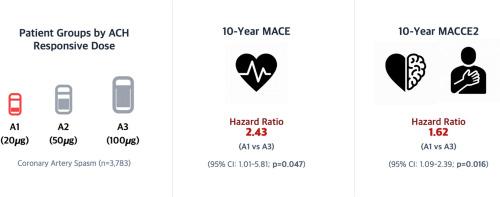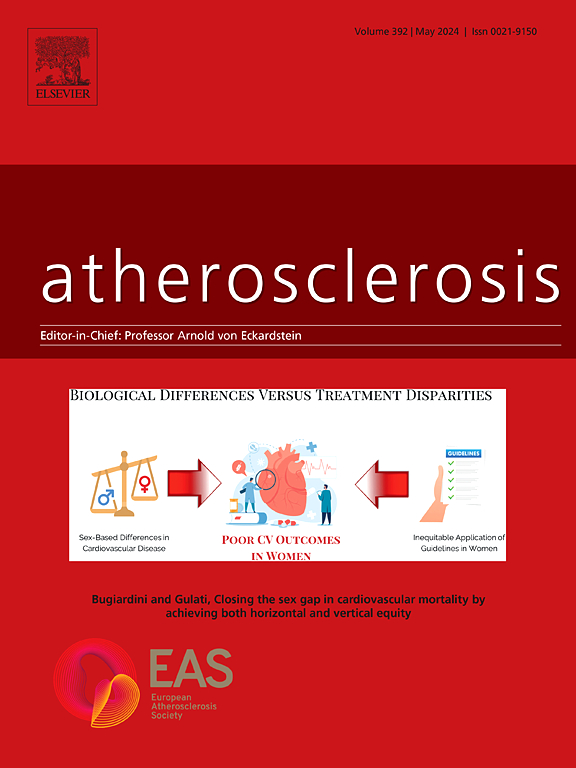Long-term clinical outcomes according to first responsive dose of acetylcholine in patients with coronary artery spasm
IF 5.7
2区 医学
Q1 CARDIAC & CARDIOVASCULAR SYSTEMS
引用次数: 0
Abstract
Background
Coronary artery spasm (CAS) has become a focus of recent prognostic studies. However, research evaluating prognosis based on the initial dose of acetylcholine (ACH) at which patients first respond is lacking. This study aims to investigate long-term clinical outcomes according to the first responsive dose of ACH in patients with CAS.
Methods
A total of 3783 patients with positive intracoronary provocation testing with ACH were categorized into three groups based on the dose at which they first exhibited a positive spasm response: A1 (20 μg), A2 (50 μg), and A3 (100 μg). The primary endpoint was major adverse cardiovascular events (MACE), and secondary endpoints included major adverse cardiovascular and cerebrovascular events (MACCE1) and MACCE1 with recurrent angina (MACCE2). Kaplan-Meier survival analysis and multivariate Cox regression were used to assess the relationship between the initial responsive dose and the clinical outcomes up to 10 years.
Results
The prevalence of coronary artery stenosis was greater in the A1 group (61.6 %) compared to the A2 group (61.1 %) and the A3 group (56.8 %). The A1 group showed a higher incidence of MACE (10.8 %) compared to the A2 group (3.7 %) and the A3 group (3.5 %, P = 0.003). MACCE2 was also more frequent in the A1 group (38.2 %) than in the A2 group (28.9 %) and the A3 group (26.4 %, P = 0.036). Consistently, in multivariable Cox regression, the A1 group demonstrated a higher risk of both MACE (HR 2.43, 95 % CI 1.01–5.81, P = 0.047) and MACCE2 (HR 1.62, 95 % CI 1.09–2.39, P = 0.016) compared to the A3 group.
Conclusion
The initial responsive dose of ACH is a potential predictor of long-term clinical outcomes in patients with CAS. Patients who respond at lower doses may have a higher risk of adverse events, indicating the need for tailored therapeutic strategies based on ACH responsiveness.

根据首次反应剂量乙酰胆碱治疗冠状动脉痉挛患者的长期临床结果
背景冠状动脉痉挛(CAS)已成为近期预后研究的焦点。然而,基于患者首次反应的乙酰胆碱(ACH)初始剂量来评估预后的研究尚缺乏。本研究旨在根据乙酰胆碱首次反应剂量来研究CAS患者的长期临床结果。方法将3783例冠状动脉内乙酰胆碱激发试验阳性患者根据首次出现痉挛阳性反应的剂量分为A1组(20 μg)、A2组(50 μg)和A3组(100 μg)。主要终点是主要心血管不良事件(MACE),次要终点包括主要心脑血管不良事件(MACCE1)和MACCE1合并复发性心绞痛(MACCE2)。Kaplan-Meier生存分析和多变量Cox回归用于评估初始反应剂量与长达10年的临床结果之间的关系。结果A1组冠状动脉狭窄发生率(61.6%)高于A2组(61.1%)和A3组(56.8%)。A1组MACE发生率(10.8%)高于A2组(3.7%)和A3组(3.5%,P = 0.003)。MACCE2在A1组(38.2%)的发生率高于A2组(28.9%)和A3组(26.4%,P = 0.036)。与此一致,在多变量Cox回归中,与A3组相比,A1组MACE (HR 2.43, 95% CI 1.01-5.81, P = 0.047)和MACCE2 (HR 1.62, 95% CI 1.09-2.39, P = 0.016)的风险更高。结论乙酰胆碱的初始反应剂量是预测CAS患者长期临床预后的一个潜在指标。低剂量反应的患者可能有更高的不良事件风险,这表明需要根据乙酰胆碱反应性制定量身定制的治疗策略。
本文章由计算机程序翻译,如有差异,请以英文原文为准。
求助全文
约1分钟内获得全文
求助全文
来源期刊

Atherosclerosis
医学-外周血管病
CiteScore
9.80
自引率
3.80%
发文量
1269
审稿时长
36 days
期刊介绍:
Atherosclerosis has an open access mirror journal Atherosclerosis: X, sharing the same aims and scope, editorial team, submission system and rigorous peer review.
Atherosclerosis brings together, from all sources, papers concerned with investigation on atherosclerosis, its risk factors and clinical manifestations. Atherosclerosis covers basic and translational, clinical and population research approaches to arterial and vascular biology and disease, as well as their risk factors including: disturbances of lipid and lipoprotein metabolism, diabetes and hypertension, thrombosis, and inflammation. The Editors are interested in original or review papers dealing with the pathogenesis, environmental, genetic and epigenetic basis, diagnosis or treatment of atherosclerosis and related diseases as well as their risk factors.
 求助内容:
求助内容: 应助结果提醒方式:
应助结果提醒方式:


